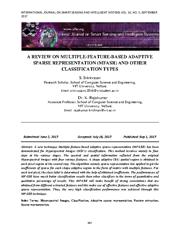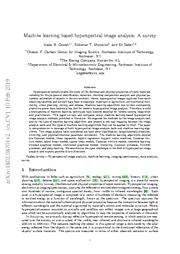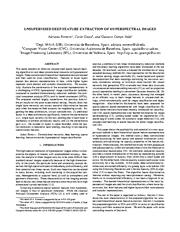A copy of this work was available on the public web and has been preserved in the Wayback Machine. The capture dates from 2020; you can also visit the original URL.
The file type is application/pdf.
Filters
Spatial Context based Angular Information Preserving Projection for Hyperspectral Image Classification
[article]
2016
arXiv
pre-print
Dimensionality reduction is a crucial preprocessing for hyperspectral data analysis - finding an appropriate subspace is often required for subsequent image classification. ...
In recent work, we proposed supervised angular information based dimensionality reduction methods to find effective subspaces. ...
SPECTRAL ANGLE-BASED DIMENSIONALITY REDUCTION A. ADA and LADA Recently, supervised angular discriminant analysis (ADA) was proposed in [14] . ...
arXiv:1607.04593v1
fatcat:vshnyg2tdfbjxmyr66gpwgpi74
Spectral–Spatial Discriminant Feature Learning for Hyperspectral Image Classification
2019
Remote Sensing
A feature evaluator is obtained by semi-supervised learning with the hypergraph Laplacian. ...
Selecting a subset of predictive features in a high-dimensional space is an important and challenging problem for hyperspectral image classification. ...
projection (LPP) [52, 53] , linear discriminant analysis (LDA) [54] , generalized discriminant analysis (GDA), Fisher discriminant analysis (LFDA), canonical correlation analysis (CCA), and local discriminant ...
doi:10.3390/rs11131552
fatcat:t63tdoffzjcudcv7nsuvza3z6i
Composite Kernel Local Angular Discriminant Analysis for Multi-Sensor Geospatial Image Analysis
[article]
2016
arXiv
pre-print
In recent work, we proposed and developed an angle-based discriminant analysis approach that projected data onto subspaces with maximal "angular" separability in the input (raw) feature space and Reproducible ...
of feature sources (e.g. from different sources), and project the data onto a unified space through composite kernels where the data are maximally separated in an angular sense. ...
A variety of feature projection approaches have been used for feature reduction, including classical approaches such as Principal Component Analysis (PCA), Linear Discriminant Analysis (LDA) and their ...
arXiv:1607.04939v1
fatcat:f4zslal3nnbezhc5r33asvbgji
A REVIEW ON MULTIPLE-FEATURE-BASED ADAPTIVE SPARSE REPRESENTATION (MFASR) AND OTHER CLASSIFICATION TYPES
2017
International Journal on Smart Sensing and Intelligent Systems
The spectral and spatial information reflected from the original Hyperspectral Images with four various features. ...
This MFASR will make benefit of strong correlations that are obtained from different extracted features and this make use of effective features and effective adaptive sparse representation. ...
., has suggested that a method named Rotation random forest via kernel principle
component analysis (RoRF -KPCA). This divides into several subsets on the feature space and
S. Srinivasan and Dr. K. ...
doi:10.21307/ijssis-2017-224
fatcat:k2x24hgfkjctxh3jwjssq5esle
Machine learning based hyperspectral image analysis: A survey
[article]
2019
arXiv
pre-print
The paper is comprehensive in coverage of both hyperspectral image analysis tasks and machine learning algorithms. ...
We also discuss the open challenges in the field of hyperspectral image analysis and explore possible future directions. ...
Supervised neural networks and dictionary learning are the examples of supervised feature learning while principal component analysis, clustering, and autoencoders are examples of unsupervised feature ...
arXiv:1802.08701v2
fatcat:bfi6qkpx2bf6bowhyloj2duugu
Unsupervised deep feature extraction of hyperspectral images
2014
2014 6th Workshop on Hyperspectral Image and Signal Processing: Evolution in Remote Sensing (WHISPERS)
principal component analysis (PCA) and its kernel counterpart (kPCA). ...
Features in lower layers present less abstract representations of data, while higher layers represent more abstract and complex characteristics. ...
/autoencoding networks [7] ; as well as projection pursuit approaches leading to convenient Gaussian domains [8] . ...
doi:10.1109/whispers.2014.8077647
dblp:conf/whispers/RomeroGC14
fatcat:2wpbpmki55bevfm22mp3vajmfq
Classification and Reconstruction From Random Projections for Hyperspectral Imagery
2013
IEEE Transactions on Geoscience and Remote Sensing
Index Terms-Dimensionality reduction, Gaussian mixture model (GMM), hyperspectral data, random projection, support vector machine (SVM). ...
It is anticipated that signal acquisition with random projections will decrease signal-sensing costs significantly; moreover, it has been demonstrated that both supervised and unsupervised statistical ...
Gamba for the Reflective Optics System Imaging Spectrometer data and L. Mann Bruce for the ProSpecTIR VNIR data. ...
doi:10.1109/tgrs.2012.2204759
fatcat:bcplojvtvvar3a4wg5quqh6aja
Automatic classification of land cover on Smith Island, VA, using HyMAP imagery
2002
IEEE Transactions on Geoscience and Remote Sensing
Unsupervised exploratory models were also developed using spatial-spectral windows and projection pursuit (PP), a class of algorithms suitable for extracting multimodal views of the data. ...
Locations of pure land cover types recorded with global positioning system (GPS) data from these surveys were used to extract spectral end-members for training and testing supervised land cover classification ...
The authors wish to acknowledge computing resources provided by the DOD High Performance Computing Modernization Program, including the Army Research Laboratory's Major Shared Resource Center, SMDC, and ...
doi:10.1109/tgrs.2002.804834
fatcat:7nubavzewrelhbjo5k6limbpjq
Regularized Sparse Band Selection via Learned Pairwise Agreement
2020
IEEE Access
Experimental results on three real urban hyperspectral data demonstrate the efficiency of the proposed RBS-LPA and achieve convincing performance. ...
Desired by sparse subset learning, in this paper, a hyperspectral band selection method via pairwise band agreement with spatial-spectral graph regularier, referred as Regularized Band Selection via Learned ...
Generally, supervised feature selection methods require a large amount of label information, in real hyperspectral scenario, supervised information is expensive to obtain. ...
doi:10.1109/access.2020.2971556
fatcat:72u7qlvq75cpnatvv773xlpxcq
Hyperspectral Remote Sensing Data Analysis and Future Challenges
2013
IEEE Geoscience and Remote Sensing Magazine
This paper presents a tutorial/overview cross section of some relevant hyperspectral data analysis methods and algorithms, organized in six main topics: data fusion, unmixing, classification, target detection ...
Very often, these applications rely on sophisticated and complex data analysis methods. ...
Before unmixing, the hyperspectral data set usually undergoes atmospheric calibration and dimension reduction. ...
doi:10.1109/mgrs.2013.2244672
fatcat:4tk7q6izd5hevhnrck36i5wkiy
Unfolding the Restrained Encountered in Hyperspectral Images
2019
International journal of recent technology and engineering
For a single scene, the hyperspectral images (HSI) are composed of hundreds of channels of spectral data. ...
Moreover with this advancement in the field of image processing, precise and huge information capturing images are desired. The hyperspectral images find its place in such fields of applications. ...
It is one of the oldest methods for the analysis of the hyperspectral data. ...
doi:10.35940/ijrte.b1763.078219
fatcat:cgdtvtrzbzaylm4eowtog52x3m
2015 Index IEEE Transactions on Geoscience and Remote Sensing Vol. 53
2015
IEEE Transactions on Geoscience and Remote Sensing
Vivone, G., +, TGRS July 2015 3931-3949
Data reduction
A Novel Feature Selection Approach Based on FODPSO and SVM. ...
., +, Spectral-Spatial Classification of Hyperspectral Data via Morphological Component Analysis-Based Image Separation. ...
doi:10.1109/tgrs.2015.2513444
fatcat:zuklkpk4gjdxjegoym5oagotzq
A genetic-algorithm-based selective principal component analysis (ga-spca) method for high-dimensional data feature extraction
2003
IEEE Transactions on Geoscience and Remote Sensing
Index Terms-Feature extraction, genetic algorithm, hyperspectral image, selective principal component analysis, supervised dimension reduction. ...
In this paper, a genetic-algorithm-based selective principal component analysis (GA-SPCA) method is proposed and tested using hyperspectral remote sensing data and ground reference data collected within ...
The authors also would like to thank ITD Spectral Visions Midwest for coordinating flight and providing images, and Precision Aviation for data collection. ...
doi:10.1109/tgrs.2003.811691
fatcat:7oxcgsv6rbhvvi3lm2df7sb4fu
Hyperspectral Image Classification
[chapter]
2019
Processing and Analysis of Hyperspectral Data [Working Title]
This chapter discusses the recent progress in the classification of HS images in the aspects of Kernel-based methods, supervised and unsupervised classifiers, classification based on sparse representation ...
Hyperspectral image (HSI) classification is a phenomenal mechanism to analyze diversified land cover in remotely sensed hyperspectral images. ...
It is well known that increasing data dimensionality and high redundancy between features might cause problems during data analysis. ...
doi:10.5772/intechopen.88925
fatcat:7ixv44bobbd3vkp7hn5c6tlb2y
HYPERSPECTRAL IMAGE SEGMENTATION USING DIMENSIONALITY REDUCTION AND CLASSICAL SEGMENTATION APPROACHES
2017
Computer Optics
To find the parameters of the algorithms and to compare the segmentation approaches, we use known measures of the segmentation quality (global consistency error and rand index) and well-known hyperspectral ...
First, we reduce the dimensionality of the hyperspectral images. Then, we apply one of classical segmentation algorithms (segmentation via clustering, region growing, or watershed transform). ...
Linear techniques including principal component analysis (PCA) [9] , independent component analysis (ICA) [10] , and projection pursuit are used more often. ...
doi:10.18287/2412-6179-2017-41-4-564-572
fatcat:6oae3y6wdrgqrlcinast6y4owm
« Previous
Showing results 1 — 15 out of 263 results















